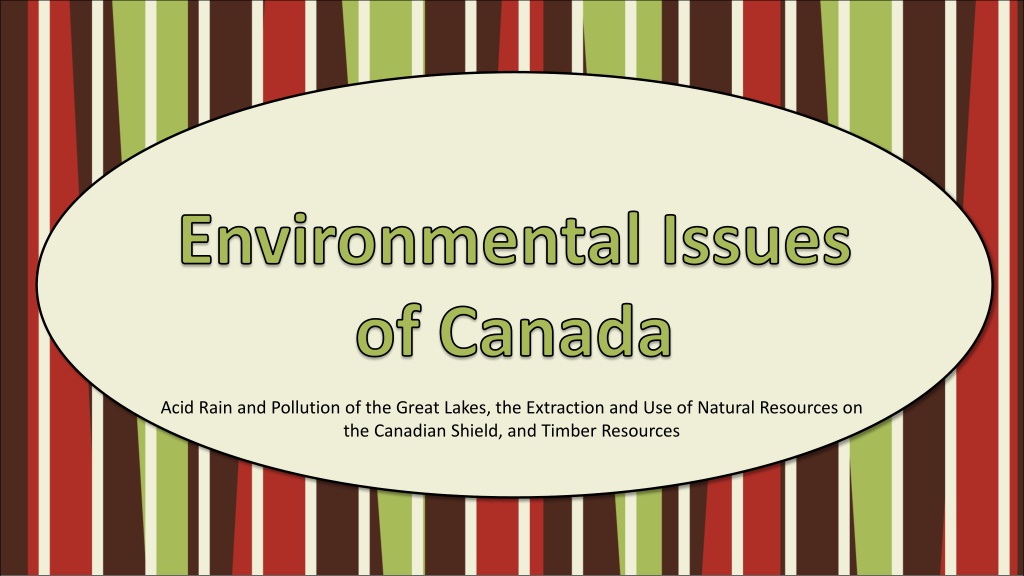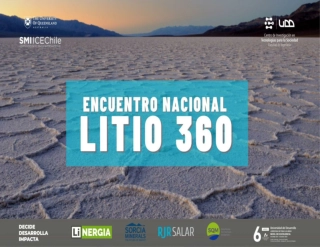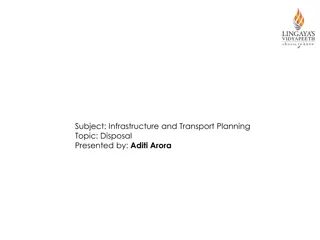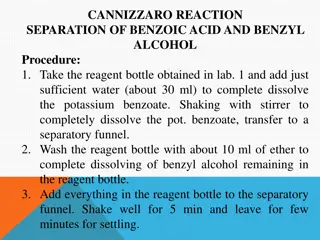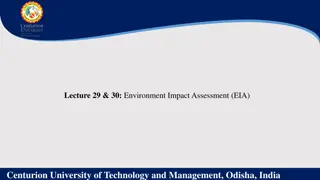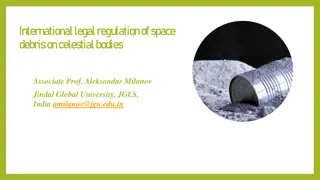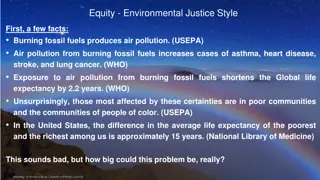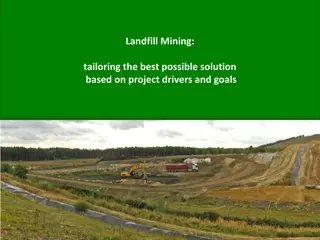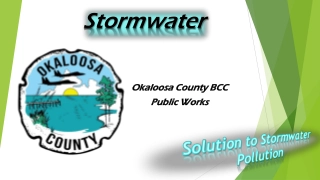Environmental Issues of Canada: Acid Rain, Pollution, and Resource Extraction
Canada faces significant environmental challenges including acid rain affecting the Great Lakes, pollution from various sources, and the extraction of natural resources like timber on the Canadian Shield. The impact of these issues on ecosystems, wildlife, and human health underscores the need for sustainable practices and environmental protection measures. Efforts to address these concerns involve government regulations, cleaner technologies, and public awareness campaigns.
Download Presentation
Please find below an Image/Link to download the presentation.
The content on the website is provided AS IS for your information and personal use only. It may not be sold, licensed, or shared on other websites without obtaining consent from the author. Download presentation by click this link. If you encounter any issues during the download, it is possible that the publisher has removed the file from their server.
Presentation Transcript
Environmental Issues of Canada Acid Rain and Pollution of the Great Lakes, the Extraction and Use of Natural Resources on the Canadian Shield, and Timber Resources
Standards SS6G7 The student will discuss environmental issues in Canada. a. Explain the major environmental concerns of Canada regarding acid rain and pollution of the Great Lakes, the extraction and use of natural resources on the Canadian Shield, and timber resources.
Environmental Issues of Canada Acid Rain and Pollution of the Great Lakes, the Extraction and Use of Natural Resources on the Canadian Shield, and Timber Resources
Acid Rain Coal-burning factories, cars, & trucks release chemicals that pollute the air. The pollutants mix with water molecules in clouds and turn the water acidic. High levels of acid in rain can damage or kill trees and pollute lakes enough to kill fish. Houses, buildings, and statues can also be damaged.
Acid Rain Southern Canada (near the Great Lakes region) experiences the highest levels of acid rain. 50-75% of the pollution that causes acid rain actually comes from the US. Wind patterns tend to move the pollution from the US north into Canada.
Acid Rain - Solution Canada s government has done several things to reduce pollution: They are building factories that don t pollute the air. Laws have been passed that require cars to produce less pollution. They are encouraging people to walk or ride bikes/buses, rather than driving.
Pollution Great Lakes In the 1970s, the Great Lakes had high levels of water pollution. Fishing was unsafe; tons of animals and plants were harmed or killed. Factories around the region used the lakes as a place to dump wastes. Factories also used the chemical phosphorus when producing things like toothpaste, fertilizer, pesticides, detergents, etc. This was really bad for lakes because it caused a rapid increase in algae.
Pollution Solution In 1971, the Great Lakes Water Quality Agreement was signed by US and Canada (renewed in 2002). The goal was to restore the lakes environment and to prevent further damage. o The countries are working together to reduce the amount of human wastes dumped in lakes. o They re working to make sure that chemicals (like phosphorus) are not put into lakes.
Extraction of Resources The Canadian Shield is a large area of thin, rocky soil that surrounds the Hudson Bay. Beneath the soil is one of Canada s most valuable resources: minerals (gold, silver, copper, zinc, lead, iron ore, uranium, & nickel). Mineral deposits are very important to Canada s economy because they provide jobs. 1.5 million people make their living in the mining industry in this area.
Extraction of Resources Blasting & digging with heavy machinery causes the land around mines to be damaged and the environment is often ruined. Slag, or leftover rock from the smelting process, is often dumped in any convenient place. Mining processes release harmful chemicals into the air, which causes acid rain.
Extraction - Solution Canada s government has made new rules about mining. Some rules reduce the amount of pollution allowed in waterways. The government hopes to keep its fish alive and safe to eat.
Timber Industry With almost half its land covered in forests, Canada is a leading producer of timber products. These products include lumber, paper, plywood, and wood pulp. The major timber-producing provinces include British Columbia, Quebec, and Ontario.
Timber Industry Citizens are concerned that logging is destroying the forests. Most timber companies cut all the trees in a given area, leaving large treeless gaps in the forest (called clear-cutting ). This reduces water quality, causes erosion, & kills animals habitats. Heavy machinery leaves the forest floor compacted and makes it hard for new growth to start. Cutting trees down quicker than they can be re-grown is called deforestation . Trees are a limited resource. If they continue to be overused, they will not be renewed.
Timber - Solution Government and industries are working together to manage use of the forests. Hundreds of millions of seedlings are planted each year. Billions of dollars are spent on managing and protecting the forests. Over $100 million is spent each year by the logging industry to protect wildlife & their habitats.
In My Opinion Ticket Out the Door Write down your opinion about one (or all) of Canada s Environmental Concerns. Please make sure you explain why you feel this way.
In My Opinion In My Opinion What s your opinion about the topic of today s lesson? Why do you feel this way? Briefly explain. What s your opinion about the topic of today s lesson? Why do you feel this way? Briefly explain.
